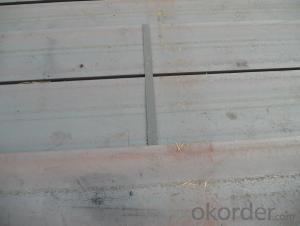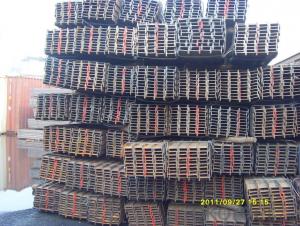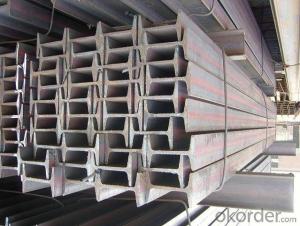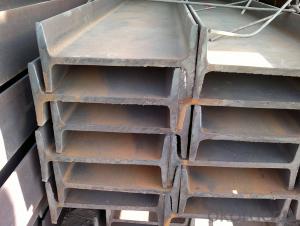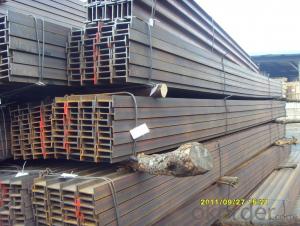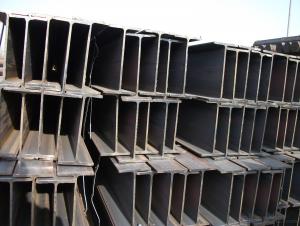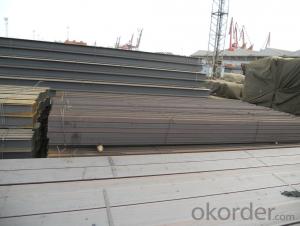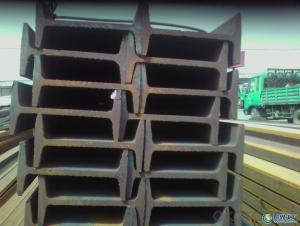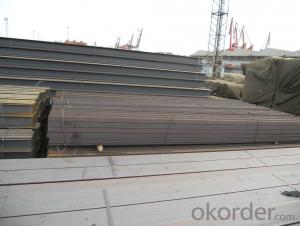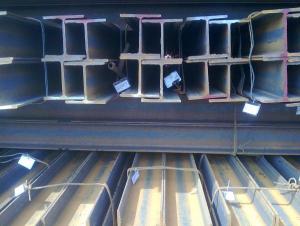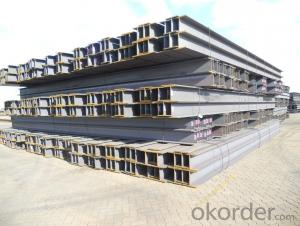Hot rolled H beams/Ibeams GB standard/JIS standard
- Loading Port:
- Tianjin
- Payment Terms:
- TT OR LC
- Min Order Qty:
- 50 m.t.
- Supply Capability:
- 2500 m.t./month
OKorder Service Pledge
OKorder Financial Service
You Might Also Like
Packaging & Delivery
Packaging Detail: packed in bundle, suitable for sea transport (by container) or According to the clients`requirements
Delivery Detail: According to the actual weight
Specifications
joist steel
high quality and factory price
large inventories
short delievery time
good after-sales service
Country of Origin: China
Mill name: Ningbo Preah Vihear Steel Industry Co., Ltd.
Commodity: H beam
Tolerance: Strictly according to the G/B and JIS standard
Delivery time: within 30days
Price term: CIF/ CFR according to clients requirements
Payment terms: 100%Irrevercable L/C At Sight or TT
Product Description
ACCORDING TO STANDARD: JIS G3192 OR GB/T11263-2005
H beam Section sizenma(mm) Weight (kg/m)
Height×Breadth Web thichness Flange thichness
100×100 6 8 16.9
125×125 6.5 9 23.6
150×150 7 10 31.1
175×175 7.5 11 40.4
200×200 8 12 49.9
250×250 9 14 71.8
300×300 10 15 93.0
300×300 15 15 105.0
350×350 12 19 134.9
400×400 13 21 171.7
148×100 6 9 20.7
194×150 6 9 29.9
244×175 7 11 43.6
294×200 8 12 55.8
340×250 9 14 78.1
390×300 10 16 104.6
440×300 11 18 120.8
482×300 11 15 110.8
488×300 11 18 124.9
582×300 12 17 132.8
588×300 12 20 147.0
100×50 5 7 9.3
125×60 6 8 13.1
150×75 5 7 14.0
175×90 5 8 18.0
198×99 4.5 7 17.8
200×100 5.5 8 20.9
248×124 5 8 25.1
250×125 6 9 29.0
298×149 5.5 8 32.0
300×150 6.5 9 36.7
346×174 6 9 41.2
350×175 7 11 49.4
396×199 7 11 56.1
400×200 8 13 65.4
446×199 8 12 65.1
450×200 9 14 74.9
496×199 9 14 77.9
500×200 10 16 88.1
596×199 10 15 92.4
600×200 11 17 103.4
700×300 13 24 181.8
800×300 14 26 206.8
900×300 16 28 240.1
- Q: How do steel H-beams perform in terms of impact resistance?
- Steel H-beams are known for their excellent impact resistance. The unique H-shaped cross-section provides a strong and rigid structure that can withstand heavy loads and impacts. This makes them highly suitable for applications where impact resistance is crucial, such as in the construction industry for supporting structures and bridges.
- Q: Are steel H-beams suitable for mezzanine flooring?
- Yes, steel H-beams are suitable for mezzanine flooring. They provide excellent support and structural stability, making them a popular choice for mezzanine construction.
- Q: Can steel H-beams be used for residential garages?
- Certainly! Residential garages can indeed utilize steel H-beams. These beams are frequently employed in construction owing to their robustness and endurance. They offer exceptional structural reinforcement, rendering them well-suited for purposes such as garage construction. Steel H-beams present several benefits, including their ability to withstand bending and warping, which ensures the stability of the garage's framework. Moreover, these beams possess a remarkable load-bearing capacity, enabling them to bear heavy weights, such as vehicles and stored items. By opting for steel H-beams in the establishment of residential garages, one can achieve a resilient and long-lasting structure that provides ample safeguarding for both vehicles and belongings.
- Q: Can steel H-beams be used for roof support?
- Yes, steel H-beams can be used for roof support. Steel H-beams are commonly used in construction as they offer great strength and load-bearing capabilities. They are often used to support the weight of roofs, as well as other structural elements in buildings.
- Q: What are the different methods of joining Steel H-Beams together?
- There are several different methods available for joining steel H-beams together, depending on the specific requirements and circumstances of the project. Some of the most common methods include welding, bolting, and riveting. 1. Welding: Welding is perhaps the most popular and widely used method for joining steel H-beams together. It involves melting the adjacent surfaces of the beams and then allowing them to cool and solidify, effectively fusing them together. Welding can be done using various techniques such as arc welding, gas welding, or laser welding, depending on the thickness and type of steel being used. 2. Bolting: Bolting is another common method for joining steel H-beams. It involves using bolts and nuts to secure the beams together. This method is often preferred when there is a need for disassembling or reassembling the structure. Bolting provides a strong and reliable connection and allows for easy adjustment or replacement of beams if needed. 3. Riveting: Riveting is a traditional method that involves using metal rivets to join steel H-beams together. It requires drilling holes in the flanges of the beams and then inserting and securing the rivets through the holes. Riveting provides a strong and durable connection, but it can be time-consuming and requires skilled labor. 4. Adhesive bonding: Adhesive bonding is a less commonly used method for joining steel H-beams together. It involves using high-strength adhesives to bond the surfaces of the beams. This method is often used in applications where welding or bolting may not be feasible or desirable, such as in certain architectural or aesthetic projects. 5. Hybrid methods: In some cases, a combination of different joining methods may be used to achieve the desired connection strength and structural integrity. For example, welding can be combined with bolting to provide additional reinforcement and stability. It is important to note that the choice of joining method depends on factors such as the load-bearing requirements, structural design, accessibility, and the skills and equipment available. Consulting with a structural engineer or a professional in the field is recommended to determine the most suitable method for a specific project.
- Q: Are steel H-beams suitable for structures with curved elements?
- No, steel H-beams are typically not suitable for structures with curved elements. They are designed to provide rigid support and stability in straight structures, and their shape does not lend well to accommodating curved elements.
- Q: Can steel H-beams be used in the construction of data centers or IT facilities?
- Yes, steel H-beams can be used in the construction of data centers or IT facilities. Steel H-beams are commonly used in structural applications due to their strength, durability, and load-bearing capabilities. In the construction of data centers or IT facilities, where the primary focus is on housing and protecting sensitive computer equipment, steel H-beams provide a solid framework for the building's structure. Data centers and IT facilities require a robust infrastructure to support the weight of heavy equipment, such as servers, switches, and storage systems. Steel H-beams possess high tensile strength and can withstand heavy loads, making them ideal for creating a stable and secure environment for sensitive IT infrastructure. Additionally, steel H-beams offer versatility in design and construction. They can be easily fabricated and connected to create customized support systems for various components within the data center. This allows for flexible layouts and efficient use of space, which is essential in data center construction. Moreover, steel H-beams have excellent fire-resistant properties, providing an added layer of safety for a data center or IT facility. The inherent fire resistance of steel helps to protect the valuable equipment housed within the facility, minimizing the risk of damage or loss in the event of a fire. Overall, steel H-beams are a popular choice for the construction of data centers and IT facilities due to their strength, durability, load-bearing capabilities, versatility, and fire-resistant properties. Their use ensures the creation of a secure and well-supported environment for the critical IT infrastructure housed within these facilities.
- Q: What are the advantages of using steel H-beams in long-span structures?
- There are numerous benefits associated with the utilization of steel H-beams in long-span structures. Firstly, steel H-beams possess exceptional strength and durability, making them an excellent choice for supporting heavy loads across long distances. The H shape of the beam enhances its structural stability, allowing it to withstand high wind and seismic forces without the risk of deformation or collapse. Consequently, steel H-beams are considered a reliable option for the construction of long-span structures such as bridges, industrial buildings, and stadiums. Moreover, steel H-beams exhibit a high load-carrying capacity, enabling them to bear substantial weight without experiencing significant deflection. This characteristic facilitates the creation of open and flexible floor plans within large buildings as the H-beams can span extensive distances without necessitating additional intermediate columns or supporting structures. Consequently, the appearance of the structure is enhanced, and more usable space is made available for a variety of purposes. Additionally, steel H-beams are relatively lightweight in comparison to other construction materials like concrete or wood. This attribute makes them easier to transport and handle during the construction process, consequently reducing construction time and labor costs and leading to overall cost savings. Another advantage of steel H-beams is their versatility. They can be easily fabricated to meet specific design requirements, providing customized solutions for long-span structures. Steel H-beams can be welded, bolted, or connected using various methods, thereby offering construction flexibility and facilitating the integration of other building components. Furthermore, steel H-beams possess excellent fire resistance properties. Due to their high melting point, steel beams can endure extreme temperatures for longer durations when compared to materials such as wood or concrete. This characteristic enhances the overall safety of the structure and reduces the risk of collapse during a fire event. Lastly, steel H-beams have a prolonged lifespan and require minimal maintenance. They are resistant to corrosion, pests, and decay, ensuring the structural integrity of long-span structures for many years. This durability reduces the need for frequent repairs or replacements, resulting in long-term cost savings and increased sustainability. In conclusion, the utilization of steel H-beams in long-span structures offers a multitude of advantages, including strength, load-carrying capacity, lightweight nature, versatility, fire resistance, and long lifespan. These benefits make steel H-beams the preferred choice for architects and engineers when designing and constructing large-scale structures.
- Q: Can steel H-beams be used for soundproofing walls?
- No, steel H-beams are not an effective material for soundproofing walls.
- Q: What are the mechanical properties of steel H-beams?
- Steel H-beams possess a variety of mechanical characteristics that render them suitable for a broad range of uses. To commence, H-beams exhibit a remarkable degree of tensile strength, enabling them to endure substantial amounts of tension or pulling forces without fracturing or distorting. This attribute renders them ideal for implementation in structures that necessitate the support of hefty loads, such as bridges or high-rise buildings. Moreover, H-beams boast exceptional yield strength, denoting the extent of stress a material can endure prior to undergoing permanent deformation. This feature guarantees that H-beams can withstand bending or buckling under substantial loads, thereby ensuring structural stability and preventing collapse. An additional significant mechanical property of steel H-beams is their rigidity or modulus of elasticity. This attribute determines the extent to which a material will deform under a given amount of stress. H-beams possess a high modulus of elasticity, signifying that they are comparatively inflexible and can sustain their shape and structural integrity even when subjected to substantial loads. Furthermore, steel H-beams exhibit commendable resistance to fatigue, permitting them to endure repeated cycles of loading and unloading without failure. This characteristic is pivotal in structures subject to dynamic loads, such as bridges or cranes, where the material is incessantly exposed to varying forces. Lastly, H-beams possess exceptional weldability, facilitating their simple fusion to form larger structures or modify existing ones. This attribute is crucial for construction endeavors that demand flexibility and adaptability in design. In conclusion, the mechanical properties of steel H-beams, comprising high tensile strength, yield strength, rigidity, fatigue resistance, and weldability, render them a popular choice in the fields of structural engineering and construction.
Send your message to us
Hot rolled H beams/Ibeams GB standard/JIS standard
- Loading Port:
- Tianjin
- Payment Terms:
- TT OR LC
- Min Order Qty:
- 50 m.t.
- Supply Capability:
- 2500 m.t./month
OKorder Service Pledge
OKorder Financial Service
Similar products
Hot products
Hot Searches
Related keywords
